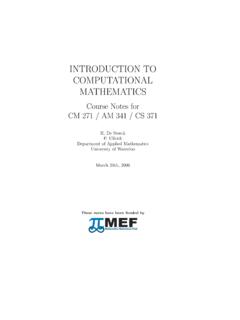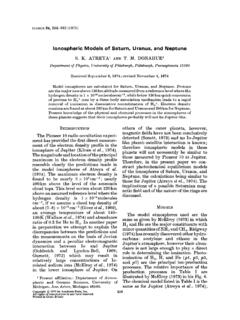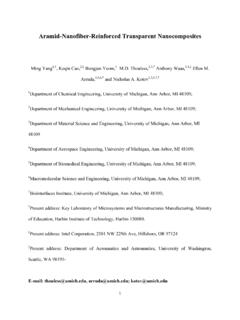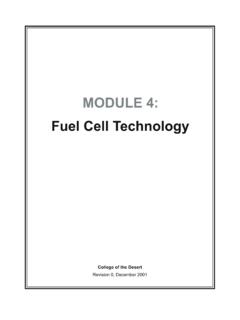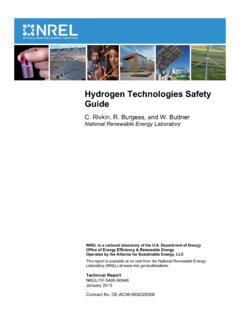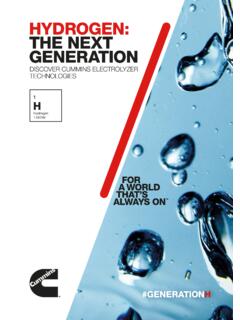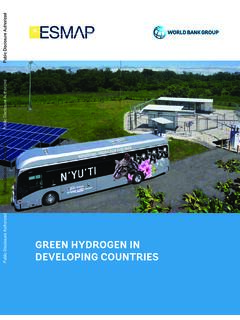Transcription of MODELING AND CONTROL OF FUEL CELL SYSTEMS AND …
1 Department of Mechanical EngineeringThe University of Michigan, Ann Arbor, MichiganMODELING AND CONTROL OF fuel CELLSYSTEMS AND fuel PROCESSORSJay Tawee PukrushpanFuel Cell StackHumidifierWater SeparatorWater TankSHydrogenTa n kSCompressorMotorEnergy Storage(Battery)PowerConditioningTMMODEL ING AND CONTROL OF fuel CELLSYSTEMS AND fuel PROCESSORSbyJay Tawee PukrushpanA dissertation submitted in partial fulfillmentof the requirements for the degree ofDoctor of Philosophy(Mechanical Engineering)in The University of Michigan2003 Doctoral Committee:Associate Professor Anna Stefanopoulou, Co-ChairAssociate Professor Huei Peng, Co-ChairProfessor Dionissios AssanisProfessor Erdogan GulariABSTRACTMODELING AND CONTROL OF fuel CELL SYSTEMS AND fuel PROCESSORSbyJay Tawee PukrushpanCo-Chairs: Anna Stefanopoulou and Huei PengFuel cell SYSTEMS offer clean and efficient energy production and are currently under intensive develop-ment by several manufacturers for both stationary and mobile applications.
2 The viability, efficiency,and robustness of this technology depend on understanding, predicting, and controlling the uniquetransient behavior of the fuel cell system. In this thesis, we employ phenomenological MODELING andmultivariable CONTROL techniques to provide fast and consistent system dynamic behavior. Moreover,a framework for analyzing and evaluating different CONTROL architectures and sensor sets is fuel cell related CONTROL problems are investigated in this study, namely, the CONTROL of thecathode oxygen supply for a high-pressure direct hydrogen fuel Cell System (FCS) and CONTROL of theanode hydrogen supply from a natural gas fuel Processor System (FPS). System dynamic analysis andcontrol design is carried out using model-based linear CONTROL approaches. A system level dynamicmodel suitable for each CONTROL problem is developed from physics-based component models. Thetransient behavior captured in the model includes flow characteristics, inertia dynamics, lumped-volume manifold filling dynamics, time evolving spatially-homogeneous reactant pressure or molefraction, membrane humidity, and the Catalytic Partial Oxidation (CPOX) reactor goal of the FCS CONTROL problem is to effectively regulate the oxygen concentration in thecathode by quickly and accurately replenishing oxygen depleted during power generation.
3 The fea-tures and limitations of different CONTROL configurations and the effect of various measurement on thecontrol performance are examined. For example, an observability analysis suggests using the stackvoltage measurement as feedback to the observer-based controller to improve the closed loop perfor-mance. The objective of the FPS CONTROL system is to regulate both the CPOX temperature and anodehydrogen concentration. Linear multivariable system analysis is used to identify the limitation of adecentralized controller and to design a model-based multivariable controller with significantly im-proved performance in CPOX temperature regulation. Further analysis unveils the critical controllercross-coupling term that contributes to the superior performance of the multivariable Jay Tawee Pukrushpan2003 All Rights ReservedTo my parentsiiiAcknowledgementsFirst and foremost, I would like to express my respect and sincere gratitude to both of my advisors,Dr.
4 Huei Peng and Dr. Anna Stefanopoulou. Without their invaluable guidance, encouragement,insightful comments and extraordinary patience, this work would never have been possible. I wouldalso like to express my gratitude to the other members of my committee, Dr. Dennis Assanis andDr. Erdogan Gulari, for their helpful advice and comments. Thanks are also due to Dr. JamesFreudenberg for his help and am deeply indebted to the Royal Thai government for granting me a scholarship for my graduatestudy and to the Department of Mechanical Engineering at Kasetsart University for supporting mystudy leave. I would also like to acknowledge the Automotive Research Center at the University ofMichigan, and the National Science Foundation for their financial support over the past two was an honor to have the opportunity to work at the United Technology Research Center duringthe past summer. I wish to thank Subbarao Varigonda, Jonas Eborn, Thordur Runolfsson, ChristophHaugstetter, Lars Pedersen, Shubhro Ghosh, and Scott Bortoff, for their help and for sharing withme their insightful knowledge of fuel processor am grateful to Scott Staley, Doug Bell, Woong-Chul Yang, and James Adams at the Ford MotorCompany for their helpful suggestions and for providing me with valuable data on the fuel cell.
5 I alsoowe a note of thanks to Larry Mianzo and Shankar Raman for allowing me to earn valuable researchand work experience during my internship at Visteon the University of Michigan, I have worked alongside many talented students. My thanks goto all of them for their kindness and friendship, but particularly to Chan-Chiao (Joe) Lin, HyungpilMoon, Kangwon (Wayne) Lee, Ali Yigit Ungoren, Bo-Chiuan Chen, Ashish Deshpande, James Dunn,Dongmei Chen, and Konstantinos Varsos. I greatly appreciate all the good times we had deepest thanks go to my dearest parents, Dr. Thanong and Dr. Lukchon, for their hard workand great sacrifices to see that their children got a good education, and above all, for always beingthere for me. I extend my thanks to Parnchat (Pe), my wonderful sister and my best friend. Lastly,my thanks and appreciation go to my wife, Chutamanee. Her love, understanding and companionshipare elements that have sustained me throughout my graduate Background and fuel Cell Propulsion System for System Reactant Flow Heat and Temperature Water Management Subsystem.
6 Power Management Subsystem .. fuel Processor LiteratureReview .. ThesisOverview .. 112 fuel Cell System Model: Auxiliary Compressor Lumped Model of the Manifold Supply Return Review of the Thermodynamics of Gas Air Cooler (Static) Humidifier (Static) 233 fuel Cell System Model: fuel Cell Stack Voltage fuel Cell Open Circuit Voltage .. Activation Ohmic Concentration Cell Terminal fuel Cell Dynamic Electrical Cathode Flow Membrane Hydration 43vii4 fuel Cell System Model: Analysis and Humidifier Hydrogen valve Steady-State Dynamic 505 Air Flow CONTROL for fuel Cell Cathode Oxygen CONTROL Problem CONTROL Dynamic Feedback CONTROL State Feedback with Integral CONTROL .
7 ObserverDesign .. Comparison with PI Closed Loop fuel Cell TradeoffBetweenTwoPerformanceObjectives .. 736 Natural Gas fuel Processor System FuelProcessingSystem(FPS).. CONTROL -OrientedFPSM odel .. Blower(BLO).. HeatExchangerVolume(HEX).. Hydro-DesulfurizerVolume(HDS) .. Mixer(MIX) .. Catalytic Partial Oxidizer (CPOX) .. Water Gas Shift Converter and Preferential Oxidation Reactor (WROX).. Anode (AN).. Simulation and Model 917 Natural Gas fuel Processor CONTROL CONTROL Problem Input-Output Decentralized Multivariable Full State Feedback with Integral State Insight into a Better Performance of MIMO Effect of 1168 FutureStudy .. 121A Miscellaneous Equations, Tables, and FPSC ontrolDesign .. 125viiiChapter 1 Background and IntroductionFuel cells are electrochemical devices that convert the chemical energy of a gaseous fuel directly intoelectricity and are widely regarded as a potential alternative stationary and mobile power complement heat engines and reduce the ubiquitous dependence on fossil fuels and thus havesignificant environmental and national security implications.
8 As such, they are actively studied forcommercial stationary power generation, residential applications, and transportation study has shown that, in the United States, Carbon dioxide (CO2) accounts for more than80% of greenhouse gases released [41] and the transportation sector is responsible for 32% of theoverallCO2emission [32]. In this thesis, we concentrate on the fuel cell CONTROL requirement duringtransients. Application of fuel cells in automotive powertrains is emphasized, partly because groundvehicle propulsion conditions present the most challenging CONTROL problem, and partly due to theirimportance in global fuel consumption and emission cell stack SYSTEMS are under intensive development by several manufacturers, with the PolymerElectrolyte Membrane (PEM) fuel cells (also known as Proton Exchange Membrane fuel cells )currently considered by many to be in a relatively more developed stage for ground vehicle fuel cells have high power density, solid electrolyte, long cell and stack life, as well as lowcorrosion.
9 They have greater efficiency when compared to heat engines and their use in modularelectricity generation and propulsion of electric vehicles is promising [62]. fuel cell efficiency is highat partial loads which correspond to the majority of urban and highway driving scenarios [88]. At anominal driving speed (30 mph) the efficiency of a fuel cell electric drive using direct hydrogen fromnatural gas is two times higher than that of a conventional internal combustion engine [91]. Using purehydrogen as fuel can eliminate local emissions problems in densely populated urban environments. Ahydrogen generation and distribution infrastructure based on renewable energy from wind, water, andsun, or fuel processors will help reduce our dependency on fossil compete with the ICE engines, however, fuel cell SYSTEMS must operate and function at leastas well as conventional engine. Transient behavior is a key requirement for the success of fuel cellvehicles.
10 The fuel cell system power response is limited only by the air and hydrogen feed, flowand pressure regulation, and heat and water management. As current is instantaneously drawn fromthe load source connected to the fuel cell stack, heat and water are generated, whereas oxygen isdepleted. During this transient, the fuel cell stack breathing CONTROL system is required to maintainoptimal temperature, membrane hydration, and partial pressure of the reactants across the membranein order to avoid detrimental degradation of the stack voltage, and thus, efficiency reduction. Thesecritical fuel cell parameters can be controlled for a wide range of current, and thus power, by a seriesof actuators such as valves, pumps, compressor motors, expander vanes, fan motors, humidifiers, andcondensers. The resulting auxiliary actuator system is needed to make fine and fast adjustmentsto satisfy performance, safety, and reliability standards that are independent of age and operatingconditions.




